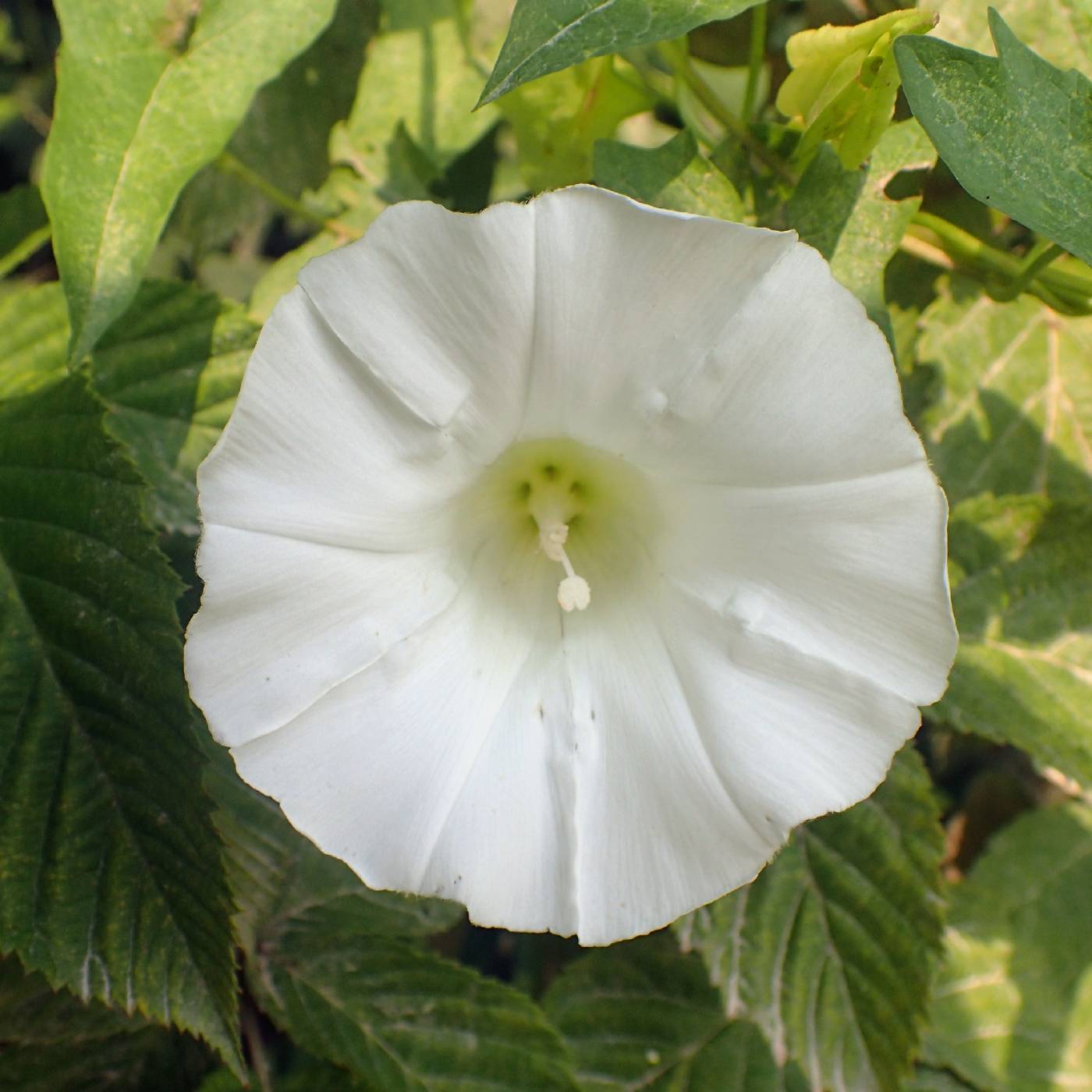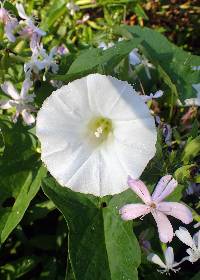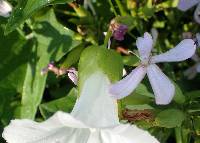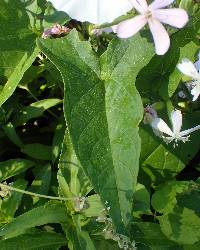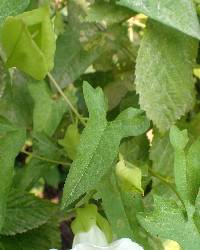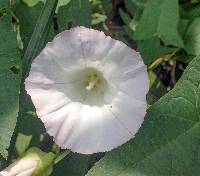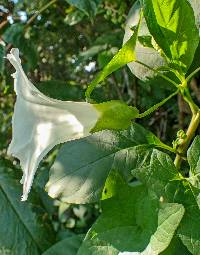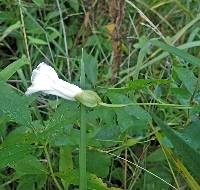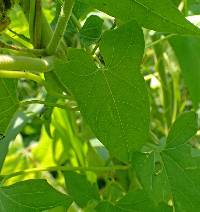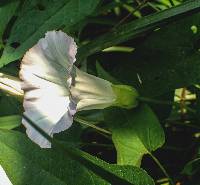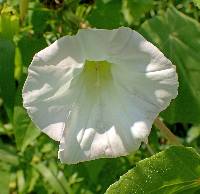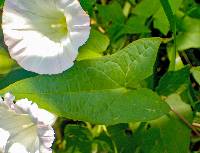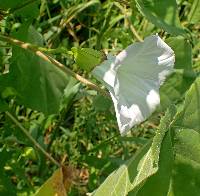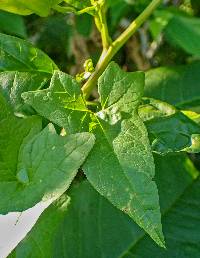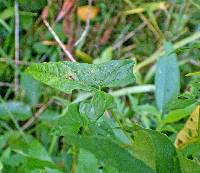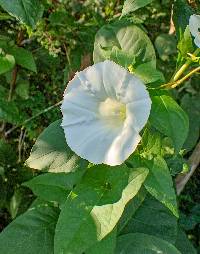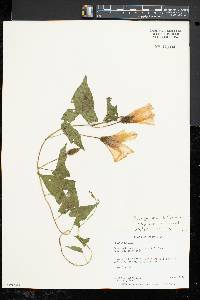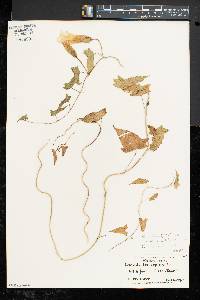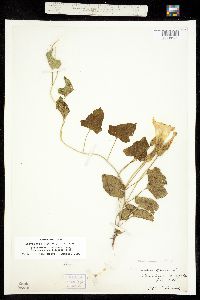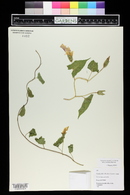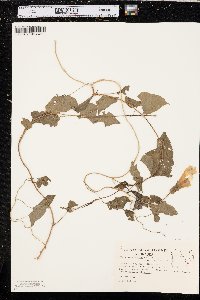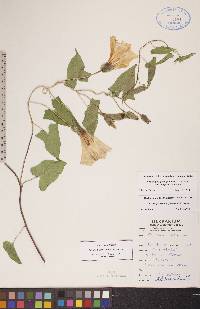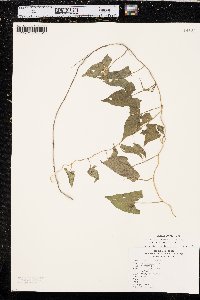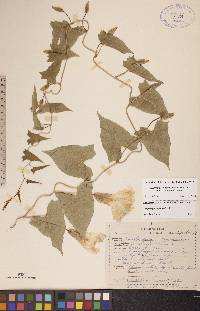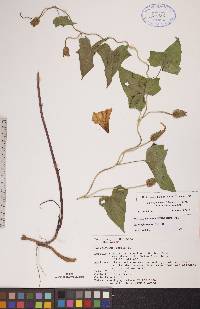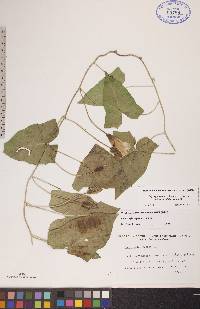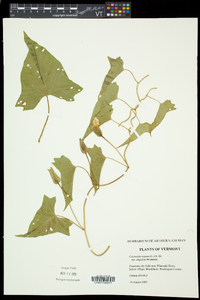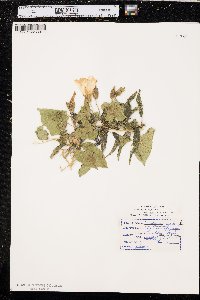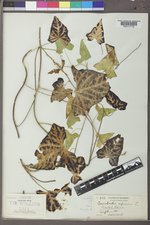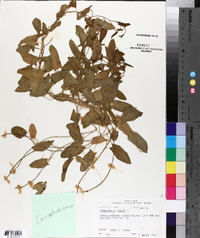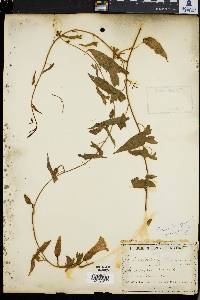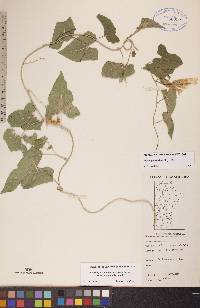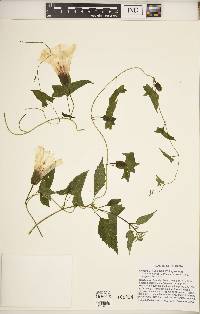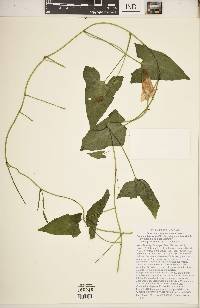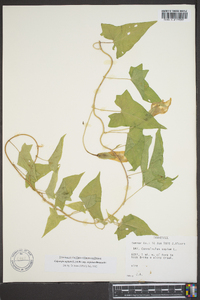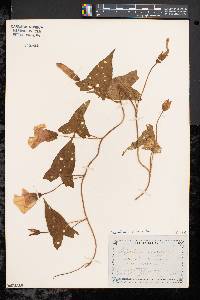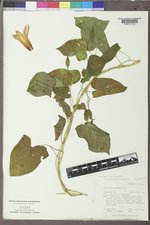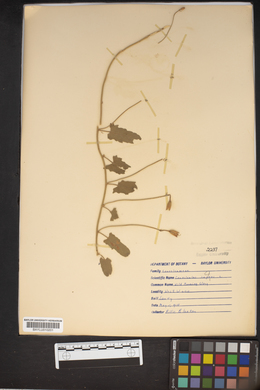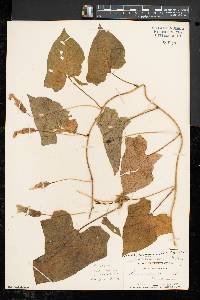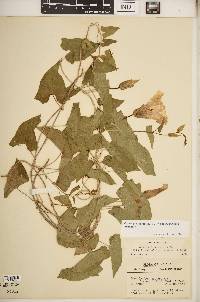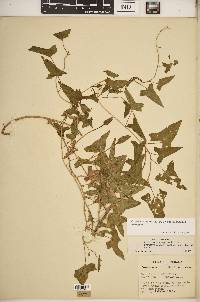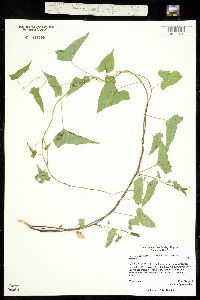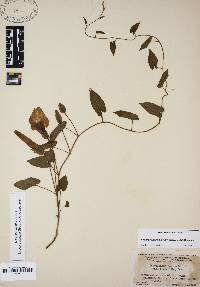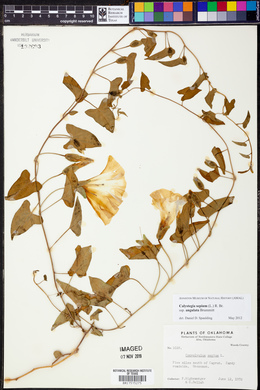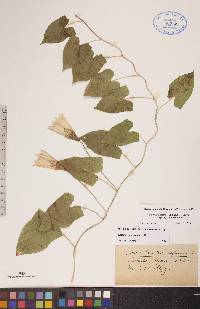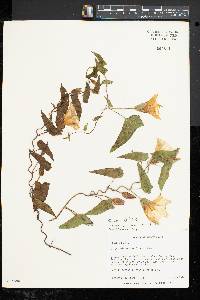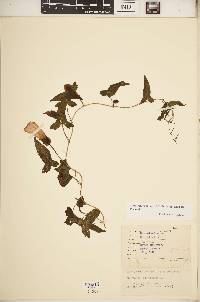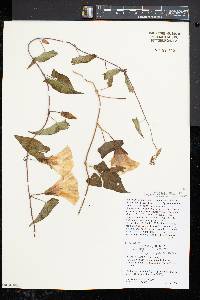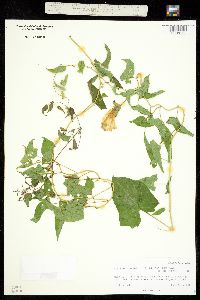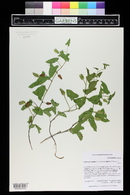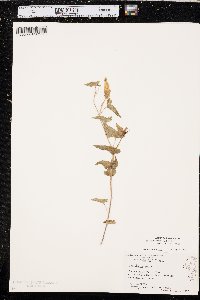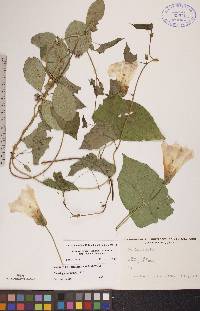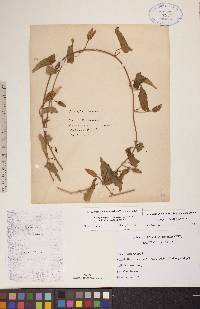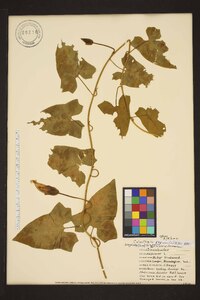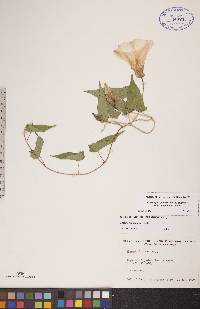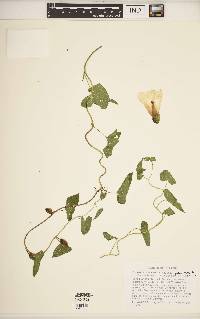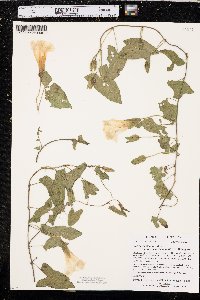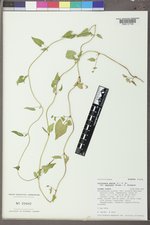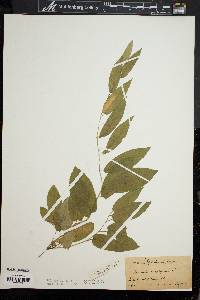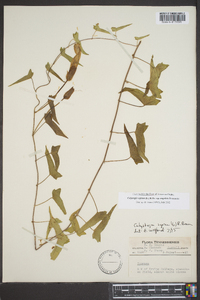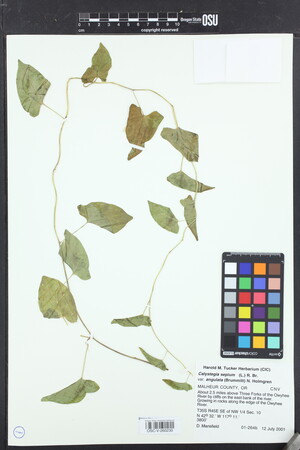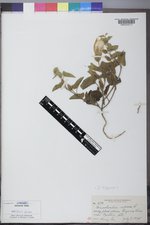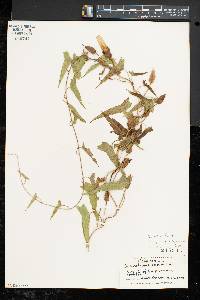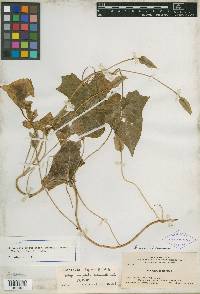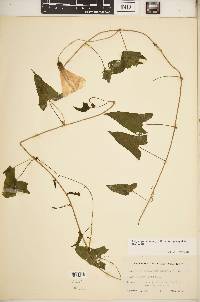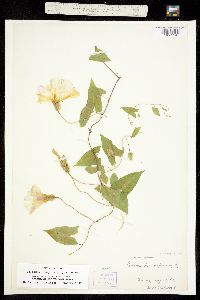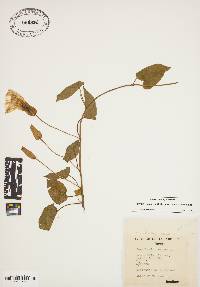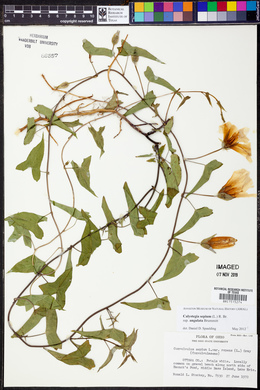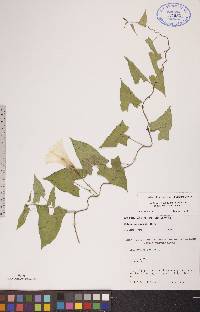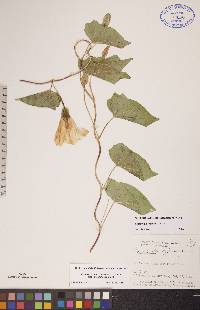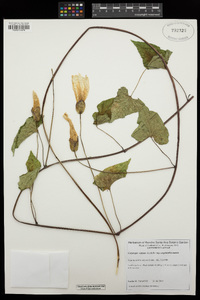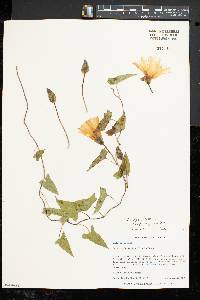
|
|
|
|
Family: Convolvulaceae
Hedge False Bindweed
[Calystegia sepium var. angulata (Brummitt) N. Holmgren, moreCalystegia sepium var. repens (L.) Gray, Convolvulus repens L., Convolvulus sepium var. repens (L.) Gray] |
PLANT: herbs with rhizomatous, twining stems, angular in cross-section, glabrous. LEAVES: ovate to ovate-lanceolate, glabrous, 2-15 cm long, 1-9 cm wide, basally cordate-sagittate to hastate, 5-nerved, the auricles obtuse to acute or 2-3 dentate, rarely 2-lobed, apically acute to acuminate, the border entire or undulate; petioles 2-7 cm long. INFLORESCENCE: of solitary flowers, on peduncles 3-13 cm long; bracts surrounding calyx angular-sulcate, ovate, convex, glabrous or ciliate, foliacous, the borders at times pinkish, 14-26 mm long, 10-18 mm wide, mucronate, mostly acute, the pedicels absent. FLOWERS: sepals elliptic to ovate-lanceolate, subequal, 11-15 mm long, 4-6 mm wide, thin, transparent, acute to almost obtuse, mucronate, apically ciliate; corollas funnelform, white or tinged on limb with rose orpink, 4.5-5.8 cm long; stamens 23-29 mm long, almost equal, basally glandular pubescent; style 20-23 mm long. FRUITS: capsular, 10-13 mm in diameter, ovoid, accompanied and partly surrounded by the enlarged bracts, which reach 30-35 mm long. SEEDS: 4.5-5 mm long, black, glabrous, smooth or granulose. NOTES: Moist habitats, near streams, elsewhere in thickets and fence rows: Cochise Co.; 1127 m. (3700 ft.); Jun-Aug; MA to WA, NC to AZ. As pointed out by Holmgren (1984) for the west, the subspecies is uncommon throughout its range. Through much of its range, this species may be confused with C. silvatica (Kitaibel) Grisebach. Living plants are easily separated. Calystegia silvatica has saccate calices, whereas C. sepium has calices that are more tightly appressed. Leaves are, however, the best way to distinguish the two species. Calystegia sepium and C. macounii have a clear V- or U-shape to the base of the leaf blade where the petiole attaches and in C. silvatica the blade base is quadrate. These differences are harder to see in pressed material, but can be detected with a little practice. Overall, leaf shape and pubescence are perhaps the easiest way to separate C. sepium from other species in the genus. REFERENCES: Austin, Daniel F. Southwestern 2006. Convolvulaceae. CANOTIA 2 (3): 79-106. Perennial vine 1 - 4 m long Stem: strongly twisting, climbing or twining, elongate, hairless, and arising from a rhizome. If the stem is cut or broken, it exudes a milky sap. Leaves: alternate, long-stalked (stalks 5 - 15 cm), non-toothed, usually hairless above, sometimes sparsely short-hairy below, 5 - 10 cm long, longer than wide, arrowhead-shaped with two short basal lobes which spread to the sides creating a distinct angle along the leaf sides, but have a wide almost U-shaped gap between them along the leaf base. Flowers: many, singly in leaf axils, long-stalked (longer than leaf stalk), white (rarely very pale pink), showy, 2.8 - 5.8 cm long, radially symmetric, tubular to funnel-shaped. Each flower is immediately subtended by two, barely overlapping, large (1.2 - 3.2 cm long, 0.6 - 1.8 cm wide), non-toothed, somewhat egg-shaped, long pointed-tipped, and slightly ridged (keeled) bracts which hide the sepals. Sepals: five, green, egg-shaped to lance-shaped, but usually obscured by larger subtending bracts. Petals: five, but fused into a long tube with expanded to flaring limb, which may be shallowly five-lobed or merely wavy along edges. Stamens: five, attached to inside base of petal tube, then separating for 1.9 - 3.1 cm, but not extending beyond petal tube. Pistil: with one, single-chambered, superior ovary; and a single, slender style which ends in two oblong, blunt, and somewhat cylindric stigmas. Fruit: stalked, several-seeded, single-chambered, rounded capsules. Similar species: Calystegia sepium ssp. angulata is not native to the Chicago Region, but has been reported several times. It may be confused with C. silvatica ssp. fraterniflora, except that taxon has sharply angled and winged flower stalks which are typically shorter than the leaf stalk, the leaves are hairy on both sides, the bracts are larger and much wider, and the flowers are usually well over 5 cm long. The most common subspecies of C. sepium in the Chicago Region is C. sepium ssp. americana, which can be distinguished by a sharp, V-shaped angle between the two basal lobes of the leaves, a long tapering pointed leaf tip, a bright pink flower, and typically somewhat hairy stems, leaf stalks, and flower stalks. The third subspecies reported in the Chicago Region, C. sepium ssp. erratica, is more rare and only definitively reported once. This subspecies if quite different from the other subspecies since the bracts and sepals are not clearly differentiated so they appear as a single spiral whorl, and the leaves have abruptly truncated, downward pointed, basal lobes with almost no space between the lobes. Flowering: June to September Habitat and ecology: Not common, found only a few times, usually along railroads. Occurence in the Chicago region: non-native Notes: This subspecies of Calystegia sepium is the most common form found in the Pacific Northwest, Rocky Mountains, Great Plains, and even some western prairie areas of North America. It is much more common to find C. sepium ssp. americana in the eastern part of North America. Etymology: Calystegia is a combination of the Greek word kalyx meaning the whorl of sepals (calyx) of a flower, and stegon, meaning cover; together referring to the bracts that conceal the calyx. Sepium means "of hedges or fences", in reference to the common occurrence of the plant on fences and within hedges due to its twining and climbing nature. Angulata means angular, in reference to the distinct angle formed between the main lobe and basal lobes of the leaves. Author: The Field Museum From Flora of Indiana (1940) by Charles C. Deam In poor clay soil in fallow fields and on bare places on open wooded slopes. Reported by Peattie for the Calumet District. Rare. |
|
|
|

